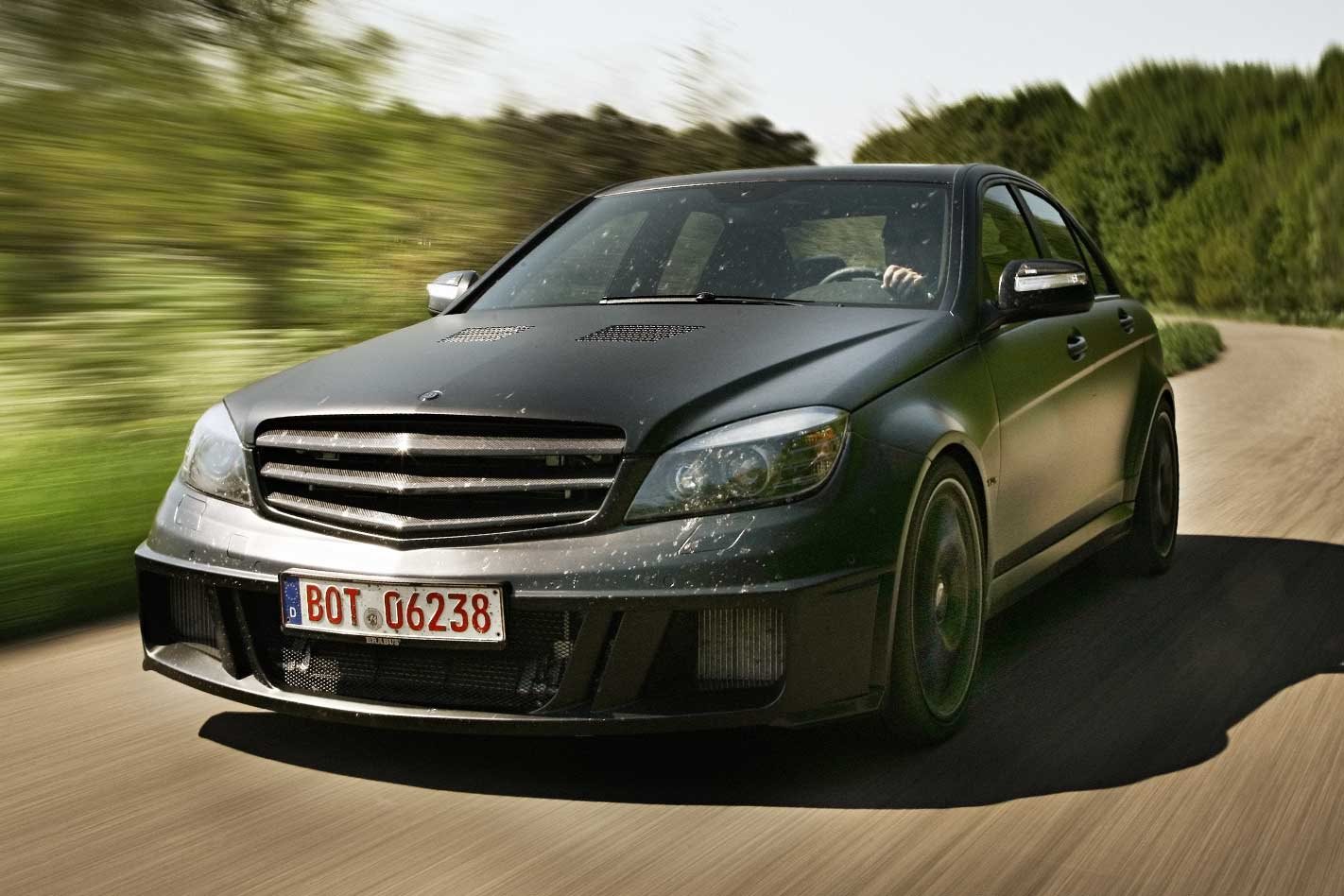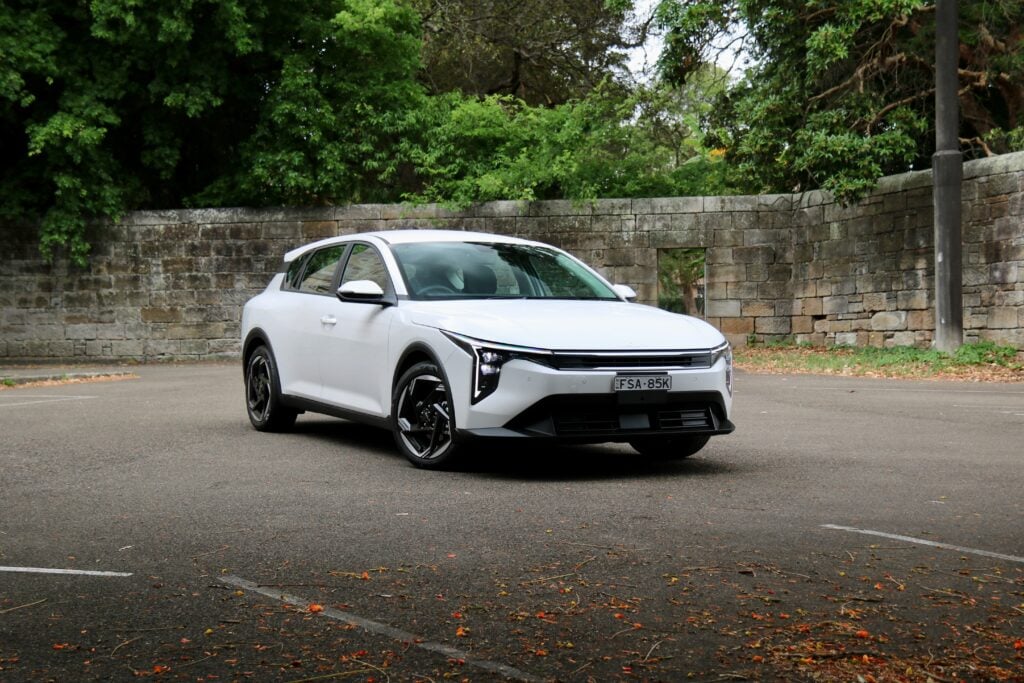The ESP warning light starts flashing at 274km/h as we drive through a fast right-hander on the busy A31 Bottrop-Emden autobahn. It’s been three hours of sweaty-palm steering and flat-out fighting this crazy C-Class drugged by Brabus. But there’s not much left to shock you. Not even stability control telling the captain of this road ship that it’s now cruising at the very limit.
This review was originally published in MOTOR’s September 2008 issue
A few miles back, when the speedo reached 315km/h, the car suddenly sounded as if the sunroof would peel off. Of course it didn’t, but the brute force of such speed managed to flip open and bend the roof-rail mounting-point covers thanks to the massive aerodynamic lift. Germany’s Brabus power brokers have computer-simulated speeds up to 370km/h, but no test drivers have yet cracked 200mph (322km/h) in the aptly named the Brabus Bullit.
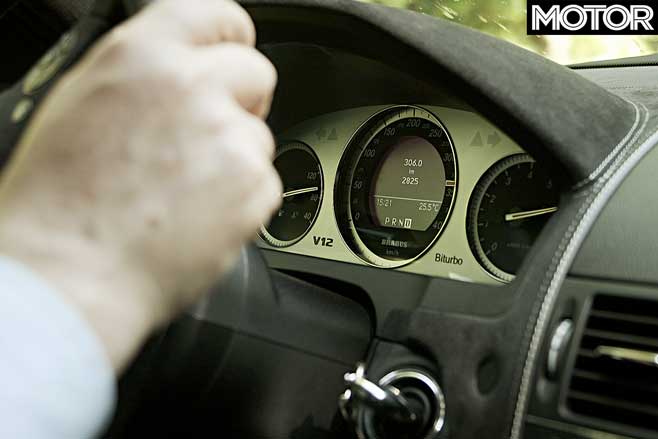
“It’s not so much the actual experience that counts but the imagination of what it be might be like to do 200, 210 or 220mph,” grins Ulrich Gauffrés, head of R&D.
“With the long axle, the Bullit would theoretically exceed 230mph [370km/h]. But because of the extreme mix of power, torque and load, we pull the plug at 219mph [350km/h]. So far, all customers opted incidentally for the ultimately less dramatic short final-drive ratio.”
The four cars built to date will reach a respectable maximum speed of 317km/h. That’s fast, but not excessively fast for Brabus, which has a long tradition of building modified Mercs capable of the speed of sound. The E V12 (based on the taxi-esque W210 E-Class) maxed out at 331km/h, the E V12 Biturbo (derived from the W211) topped an honest 352km/h, and the CLS Rocket passed the light bar on the Nardo oval in Italy at 367km/h.

Although lighter and smaller, the Bullit is equipped with the same 537kW V12, but — perhaps for political reasons — is not allowed to eclipse the more expensive Rocket. It’s limited to 350km/h when fitted with the 2.24 final-drive.
After a few high-speed runs, it becomes clear why hitting even the 200mph (322km/h) mark is plenty. The exhausted Yokohamas smell like an F1 grid just after the red lights have gone out, and they’re hot enough to fry bugs before getting a chance to squash them. Give it stick and the Bullit will instantly ricochet, fishtail, squeal and be a general nuisance to all the good guys on the road.
Whipped hard, it briefly feigns a front-to-rear weight distribution of 90-to-10, lets the rear attempt to overtake the front, and encourages an epic battle between the clever electronics and the monstrous 1320Nm of torque – limited electronically to 1100Nm to protect the drivetrain.
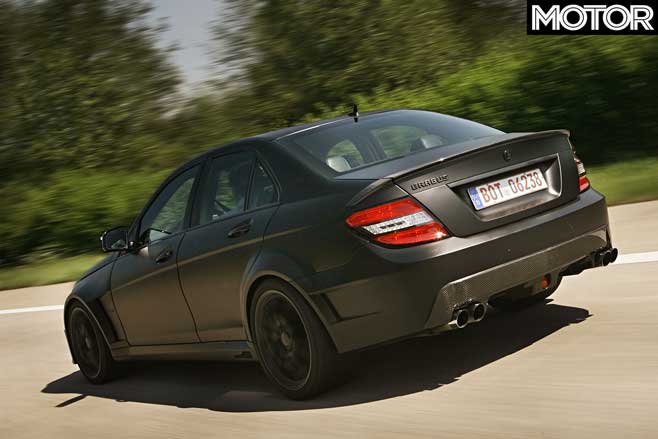
Its loud character matches its performance, and would likely receive a unanimous thumbs-up from the likes of P. Diddy, Marilyn Manson or Hulk Hogan. The test car looked particularly satanic, its original silver body covered by a dark matt-black coating for an extra €4000 ($6500).
The gothic treatment may be super cool, but stone chips will tear up the surface finish, which is notably more relaxed in places than solid paint. Matching the stealth bodysuit are dark 19-inch alloy wheels, carbonfibre grille and rear apron, generous wing and sill extensions, rear spoiler and wide-mouth front bumper which feeds plenty of air into the brake-cooling ducts and the radiators.
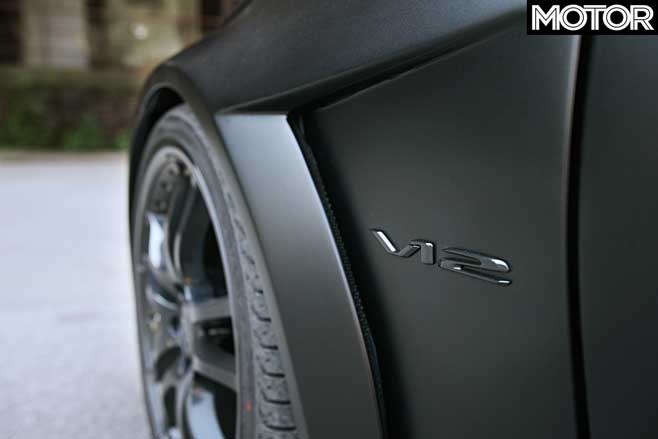
The Brabus Bullit Black Arrow (to give its full name) boasts a twin-turbo 6.2-litre V12 that musters 537kW at 5100rpm, and max torque of 1100Nm from 2100-3000rpm. Compared to the base 5.5, the uprated V12 features a longer-stroke crankshaft, bigger-bore cylinders and heads, special pistons and conrods, high-performance camshafts, a pair of intercooled turbos and a revised free-flow exhaust brutal enough to crack open nesting bird eggs a kay away.
About as ancient as the three-valve heads is the reinforced five-speed auto, but when there’s more torque than a run-of-the-mill turboprop, the number of gears becomes virtually irrelevant. The downside is the absence of shift paddles, which would have suited the overkill character of this beast. You can always stir the column-mounted shifter, but considering the rear axle’s tap-dance talents, having both hands on the wheel is a better idea.
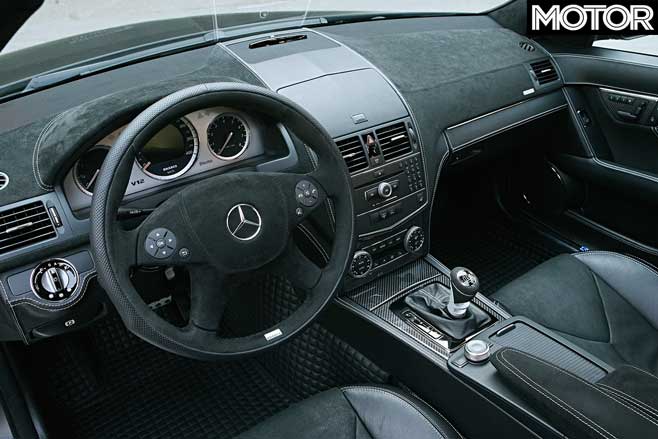
However, such a modern, high-tech super sports car lacks certain features like ESP Sport (an in-between mode which permits more wheelspin), a choice of transmission driving programs and shift speeds, and a hooligan button to trigger launch control.
Although weighing a feisty 1850kg, traction is always an issue. To balance the unladen rear axle and nose-heavy front suspension, engineers fitted a limited-slip differential with a 40-percent locking rate. Traction- and stability-control also help, as do the 285/30ZR19 rear Yokohamas which are a little fatter than the 265/30ZR19 footwear chosen for the front wheels.
New for this superior C-Class are beefier anti-roll bars, a wider track (two inches), high-performance brakes and a specially prepared spring and damper set-up, adjustable from reasonably compliant to virtually solid.
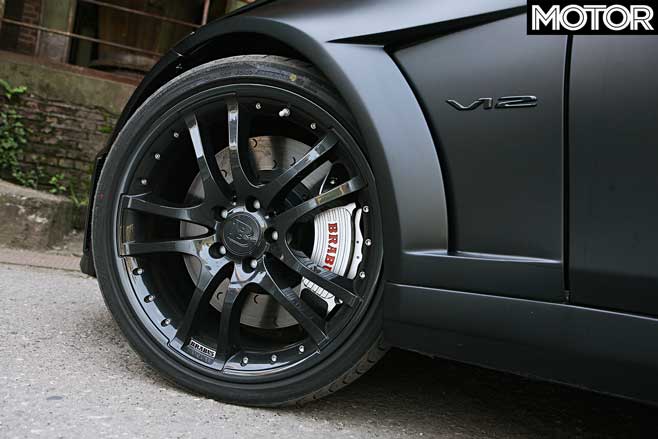
Extra money buys carbonfibre brake discs, but the standard all-steel stoppers are better suited for everyday use. Combining 12-piston fixed calipers and 380mm rotors in front with six-piston calipers and 360mm discs at the rear, the Bullit decelerates with vigour and spontaneity.
On a grippy airport runway, acceleration from 0-100km/h takes only 3.9sec and 200km/h just 10.5. In another 14sec, it will thunder past the 300km/h barrier. While the S63 AMG or the BMW M5 start running out of steam at 250km/h, this monster from Bottrop keeps charging ahead like a raging gas turbine right up to 300.
To save stress and fuel, fifth gear kicks in relatively early, but there’s still so much oomph on tap that this Merc on steroids will peak at an indicated 327km/h, which is all the shorter 2.65:1 axle allows. That’s not enough to qualify for the Guinness World Records but it’s plenty to show it has guts and foresight when pushed to the limit.

The downside of this v-max, though, is crippling fuel consumption. Instead of an advertised average of 15.1L/100km, the test car returned 29.1L/100km in foot-to-the-floor mode, the measly 66-litre tank empty after just 197km.
Brabus chose a mix-n-match suspension setting that is fine for secondary roads. On the autobahn, however, we’d encourage a few subtle set-up changes. The front end felt a little stiff in the springs, while the rear spring and damper set-up was a touch on the cushy side — allowing too much lift and vertical movement, and meaning directional stability isn’t quite arrow-straight.
It’s a minor issue, and could be fixed rather quickly, but at speeds over 320km/h you need total confidence, absolute clarity and reassuring composure. Although the Bullit is nine-tenths there, it could be even better tied down and more stoic in how it relays road and driver inputs.
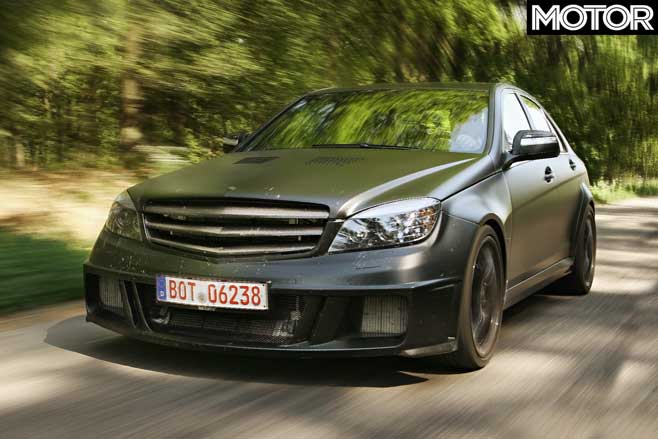
Up to 200km/h — when aerodynamics take a back seat and the suspension feels well connected — the Bullit is a hoot. On-ramps are perfect to stage lurid slides, traffic lights encourage you to leave behind black stripes and grey smoke signals, while on-demand third-gear wheelspin, even in the dry, never fails to make your passengers turn a shade whiter.
Any second-gear corner that’s clear from entry to exit beckons for a drift-challenge audition. Trouble is, other motorists aren’t prepared for a rowdy baby Benz going OTT, and the law is entitled to interpret even mild drifts as reckless driving.
That’s why a muscle machine like this deserves a race track, a drag strip or at least an empty car park without too many light posts hindering one’s impromptu auto slalom.

With ESP switched on, the roaring V12 is reigned in by a mastermind black box. With ESP deactivated, just about every stab at the throttle requires a handful of opposite lock. At first it’s a lot of fun, but it leaves you wondering if Brabus ever considered an all-wheel-drive version.
There’s no doubt about it: this C-Class with up-rooted, re-routed DNA is a wild zombie cocktail which should wear skull-and-crossbone stickers. The V12 is an alien ingredient, but those who aren’t gifted with superhuman reflexes may actually appreciate the fact that opposite lock can be applied in generous, leisurely doses. More than once the Brabus indulged ‘almost’ full spins, only to rescue itself after a deep-breath downshift.
In addition to essential factory options like sat-nav, xenon lights, power-operated memory seats, Keyless Go and the totally counter-productive sunroof, our Bullit sported classic Brabus add-ons such as full leather and Alcantara trim (costing roughly $32,700, which also includes hide-covered footwells) and an extensive carbonfibre pack. Although the base version can hardly be described as a bargain, our fine specimen commanded an even more outrageous asking price of €451,138 ($737,349).

In terms of value for money, the ballsiest C-Class on the market is very expensive compared to, say, the quicker and faster Porsche 911 GT2. But it’s cheap in relation to, well, a Veyron (but what isn’t?). What you get isn’t just about how much the parts cost, though, but a made-to-measure, well-engineered car that’s been properly developed.
The Brabus Bullit Black Arrow is a quality piece of kit, somewhat of a government-certified, crash-tested ecstasy pill on wheels. No, the Bullit certainly doesn’t make a perfect second or third car. But Mercedes-minded multi-millionaires will be hard pressed to find a more exciting plaything. For the ultimate in understatement, though, might we suggest a coating of German-taxi beige?
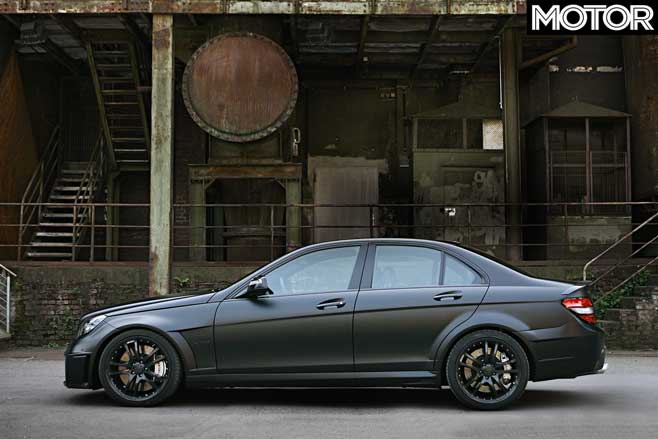
FAST FACTS Brabus Bullit BODY: 4-door, 4-seat sedan DRIVE: rear-wheel ENGINE: 6233cc V12, DOHC, 36v, twin turbo BORE/STROKE: 83.0 x 96.0mm COMPRESSION: 9.0:1 POWER: 537kW @ 5100rpm TORQUE: 1100Nm @ 2100-3000rpm* WEIGHT: 1850kg POWER-TO- WEIGHT: 290kW/tonne 0-100KM/H: 3.7sec (claimed) TOP SPEED: 350km/h (limited)** TRANSMISSION: 5-speed automatic SUSPENSION: double A-arms, coil springs, anti-roll bar (f); multi-links, coil springs, anti-roll bar (r) L/W/h: 4590/1830/1402mm WHEELBASE: 2761mm TRACKS: 1538/1539mm (f/r) STEERING: power rack-and-pinion BRAKES: 380mm ventilated/grooved discs, 12-piston calipers (f), 360mm ventilated/grooved discs six-piston calipers (r) WHEELS: 19 x 9.5-inch (f), 19 x 10.0-inch (r) TYRES: Yokohama Advan V103; 265/30ZR19 (f), 285/30ZR19 (r) PRICE: €451,138 ($731,870)
RATING: 9.5 out of 10 stars
*electronically limited **with 2.24 final drive
It’s not just an engine

Read anything on a Brabus — any model — and it’s all about power and performance. But the Bullit is a more than just a big donk shoved in a small Benz. Covering ground at more than 300km/h requires some serious body mods, beginning with the C-Class shell.
The front and rear wheelarch extensions are aluminium, adding 2.36-inches (60mm) to the Bullit’s width. The bonnet is also aluminium, with cooling slots added, while at the rear a three-piece spoiler sits above a carbonfibre apron with an integrated diffuser. The front apron is also made of autoclave-baked carbonfibre, with cooling for the biturbo V12 and 12-piston brakes provided by larger air intakes.

